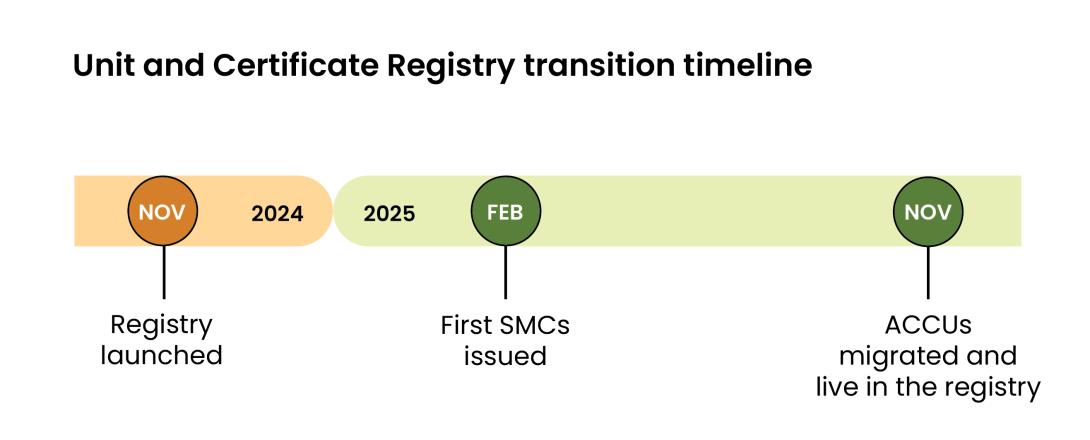The Unit and Certificate Registry is a modern, easy-to-use system that allows account holders to manage and trade the units and certificates we administer.
The registry is foundational infrastructure that will support the ongoing growth of deep, liquid and transparent Australian carbon markets.
The registry houses units and certificates administered by the Clean Energy Regulator (CER). It provides a digital record and is the source of truth of all holdings and transactions of units and certificates.
The registry is built on Trovio’s CorTenX – a scalable, customisable and secure technology for environmental assets. It uses an application programming interface (API) first design.
The registry makes it easier for account holders to:
- view and trade units and certificates
- meet their regulatory obligations
- engage in voluntary emissions reduction by consolidating multiple unit and certificate types in a single location.
The registry will progressively hold multiple account types, including:
- Australian National Registry of Emissions Units (ANREU) accounts
- Guarantee of Origin accounts
- Nature Repair Market scheme accounts.
The registry will continue to be upgraded with new functionality, including interoperability between the registry and external account holder systems and trading platforms.
Types of units and certificates in the new registry
The registry will progressively include different unit and certificate types. Some are already available, while others will migrate across or be issued over the coming months.
Available in the registry
- Safeguard Mechanism credit units (SMCs) – February 2025
- Australian carbon credit units (ACCUs) – November 2025
Coming to the registry
- Renewable Electricity Guarantee of Origin certificates
- Product Guarantee of Origin certificates
- Biodiversity certificates (under the new Nature Repair Market scheme)
For the time being, certified emission reduction (CER) units will remain in the ANREU system, and large-scale generation certificates (LGCs) and small-scale technology certificates (STCs) will remain in the REC Registry.
Transition to the registry
The transition to the registry will happen in stages. The registry will improve how units and certificates are managed.
- November 2024 – Registry launched
- February 2025 – First SMCs issued in the registry
- November 2025 – ACCUs migrated into the registry
Other certificate types will be issued through the registry, but timing is still to be determined.

ACCU migration
The migration of ACCUs into the registry is now complete.
To ensure the accuracy and completeness of the migration, we have undertaken a thorough reconciliation process, which has been reviewed by an independent auditor. Following these assurance activities, all ACCU holdings and transaction histories are now available for ANREU account holders in the registry.
ACCU functionality in the registry
All ACCUs held in ANREU accounts are now managed in the registry. ACCUs are no longer held or managed in the ANREU system. The registry is now used to:
- view ACCU holdings
- transfer ACCUs
- deliver ACCUs under carbon abatement contract
- surrender ACCUs to meet safeguard obligations
- voluntarily cancel ACCUs.
ACCU attributes in the registry
In the registry, it is easier to view and filter ACCU holdings by attribute. All ACCU attributes, including project related information such as method, are based on information ‘at time of issuance’ and will not change. The table outlines all attributes and their definition.
| Attribute | Definition | Example |
|---|---|---|
| Project ID | ID number of the project | ERF123456 |
| Project name | Name of the project | Project XYZ |
| Method type | Type of project | Vegetation |
| Method | ACCU Scheme method under which the project generated abatement | Reforestation by environmental or mallee plantings FullCAM 2024 |
| Vintage | Financial year in which the ACCU was issued | 2024–25 |
| Location | States or territories in which the project operated | NSW |
| Issuance date | Date the ACCU was issued | 2025-01-04 |
| Serial range | Serialised identification number for the ACCU. Groups of ACCUs are issued in blocks – the serial range shows the first and last serial number held by ACCUs in the block of units | 3,605,318,522 - 3,605,318,900 |
| Category | Type of ACCU – Kyoto ACCU or Non-Kyoto ACCU | KACCU |
Benefits
The registry provides a modern, secure, single place to hold and transfer multiple unit and certificate types. It will improve the:
- user experience for managing and transferring holdings
- accessibility and visibility of unit and certificate attribute data
- account creation and management experience
- ability of users to download, share and manage registry data
- integration of the registry with our other online systems, giving users a more seamless experience.
The registry will also have the capability to integrate with external systems and digital trading platforms.
Unit and Certificate Registry guidance
For information on how to access and navigate the registry, read our Unit and Certificate Registry guidance.
Public disclosure statement
We have partnered with Trovio Operating Pty Ltd to undertake work to deliver and operate the Unit and Certificate Registry.
We have prepared a public disclosure statement to ensure transparency and maintain public trust in the operation of the registry.
View the public disclosure statement.